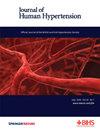配偶年龄差异与女性患高血压的风险:来自印度的证据。
IF 3.4
4区 医学
Q2 PERIPHERAL VASCULAR DISEASE
引用次数: 0
摘要
在记录高血压的社会心理风险因素方面取得了稳步进展。然而,大多数现有证据都是基于发达国家的人口。这项横断面研究利用印度具有全国代表性的数据,探讨了配偶年龄差距是否与 20 至 49 岁已婚妇女的高血压风险有关。根据与丈夫的年龄差距,妇女被分为四类:丈夫--i) 年龄相仿;ii) 大 3-5 岁;iii) 大 6-9 岁;iv) 大 10 岁以上。与丈夫年龄相仿的妇女相比,其他类别妇女患高血压的几率是通过估计多变量逻辑回归模型来评估的。我们样本中的高血压患病率为 18.9%,而丈夫年龄相仿的妇女的患病率要低 2.2 个百分点,丈夫年龄超过 10 岁的妇女的患病率要高 3.3 个百分点。配偶年龄相差 10 岁以上的妇女患高血压的调整后几率是与丈夫年龄相仿的妇女的 1.18 倍(95% CI:1.13-1.24)。这些结果在年轻(20-34 岁)和年长(35-49 岁)的女性中都持续存在,并且在不同的结婚年龄、婚姻年限和不同的社会经济分组(包括女性的教育程度、丈夫的教育水平、家庭财富、城市/农村居住地和地理区域)中都很稳定。在对丈夫的高血压状况进行调整后,这种关系依然存在。因此,我们的研究结果凸显了配偶年龄差异是影响女性高血压风险的一个生物心理社会因素。本文章由计算机程序翻译,如有差异,请以英文原文为准。

Spousal age difference and risk of hypertension in women: evidence from India
There has been steady progress in documenting the psychosocial risk factors of hypertension. However, most of the extant evidence is based on population from the developed countries. Using nationally representative data from India, this cross-sectional study explores whether spousal age gap is associated with risk of hypertension in married women aged 20 to 49 years. Based on the age difference with their husbands, women were grouped into four categories: husband was – i) of similar age, ii) 3–5 years older, iii) 6–9 years older, and iv) 10+ years older. Compared to women whose husbands were of similar age, the odds of having hypertension for the other categories were assessed by estimating multivariable logistic regression models. While the hypertension prevalence in our sample was 18.9%, it was 2.2%-points lower among women whose husbands were of similar age, and 3.3%-points higher among women whose husbands were 10+ years older. The adjusted odds of having hypertension for women with 10+ years of spousal age difference were 1.18 (95% CI: 1.13–1.24) times that of their counterparts who were of similar age to their husbands. These results were persistent in both younger (age 20–34) and older (age 35–49) women and robust across age at marriage, years in marriage, and various socioeconomic sub-groups including women’s educational attainment, husband’s educational level, household wealth, urban/rural residence, and geographic regions. The relationship also persisted after adjusting for husband’s hypertension status. Our findings thus highlight spousal age difference as a biopsychosocial factor influencing the risk of hypertension in women.
求助全文
通过发布文献求助,成功后即可免费获取论文全文。
去求助
来源期刊

Journal of Human Hypertension
医学-外周血管病
CiteScore
5.20
自引率
3.70%
发文量
126
审稿时长
6-12 weeks
期刊介绍:
Journal of Human Hypertension is published monthly and is of interest to health care professionals who deal with hypertension (specialists, internists, primary care physicians) and public health workers. We believe that our patients benefit from robust scientific data that are based on well conducted clinical trials. We also believe that basic sciences are the foundations on which we build our knowledge of clinical conditions and their management. Towards this end, although we are primarily a clinical based journal, we also welcome suitable basic sciences studies that promote our understanding of human hypertension.
The journal aims to perform the dual role of increasing knowledge in the field of high blood pressure as well as improving the standard of care of patients. The editors will consider for publication all suitable papers dealing directly or indirectly with clinical aspects of hypertension, including but not limited to epidemiology, pathophysiology, therapeutics and basic sciences involving human subjects or tissues. We also consider papers from all specialties such as ophthalmology, cardiology, nephrology, obstetrics and stroke medicine that deal with the various aspects of hypertension and its complications.
 求助内容:
求助内容: 应助结果提醒方式:
应助结果提醒方式:


